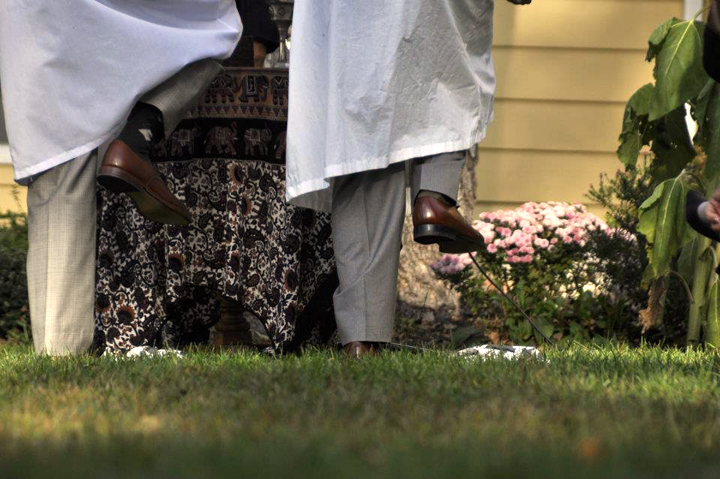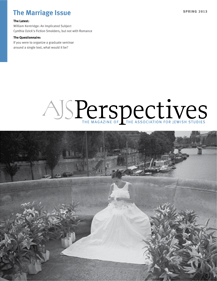
The answer, as of a few months ago, was exactly what one has come to expect (for better and for worse) from the Conservative movement: both. The Committee on Jewish Law and Standards offered a traditional liturgy, but without kiddushin, as well as an alternative liturgy with different language and different ritual forms (no chuppah, no rings, etc.).
This result is not particularly interesting, as it is but the latest in the movement’s (take your pick) pluralism/vibrancy, or paralysis/discord. But the debate surrounding the question, and its unintended consequences, are fascinating.
First, there were multiple—and diametrically opposed— rationales for alternatives to the traditional model. On the one hand, some LGBT advocates—myself included—favored a ritual that didn’t mimic a straight wedding but recognized that a gay wedding is importantly and productively different. On the other hand, some small-c conservatives favored a different ritual so that it wouldn’t be confused with a “real” wedding. The rabbis on the law committee were caught in the middle. Is “different from” always “less than”? Is separate inherently unequal?
And then there was the issue of kiddushin. For at least thirty years now, feminists have critiqued this legal form—in which the groom effectively buys the bride—as outrageous. Kiddushin seemed particularly out of place in a same-sex wedding. Who buys whom? And if a new ritual is being created, isn’t this the perfect time to dispense with this old, offensive, and outmoded form?
The law committee, following the pioneering work of Rachel Adler, tended to agree. But then the law of unintended consequences kicked in. With kiddushin no longer mandatory for gay couples, some straight couples have already begun adapting the gay liturgy for their own egalitarian nuptials. After all, the reasoning goes, if the kiddushin-free rite is equally valid as the traditional one, why shouldn’t it apply to heterosexual couples as well? Do straight people now have fewer options than gay people?
There are those who have complained about this unexpected, but perhaps foreseeable, development. They see it as a back-door sabotaging of kiddushin, and, though I have yet to read anyone saying so in print, conservatives might well point to this turn of events as evidence that same-sex marriage actually is changing marriage for everyone. In some ways, this is a nightmare come true for those who disparage gay marriage.
I have a different view, naturally. To develop it, I want to go back to my brash introductory sentences about marriage equality and inequality. From the outset, there have been multiple strands to the LGBT movement, just as there are in feminism and in anti-racism and anti-oppression work of all kinds. There are those in my community who espouse a basically assimilationist message: let us in (to rabbinical school, to the rite of marriage, etc.) because we are basically the same as you. We are not here to transform institutions, but to join them. We want only what you already have. This is the dominant argument, and the argument that is politically the most effective.
But then there are the more radical voices with a different message. Let us in, they say, not because we are the same as you, but because we are relevantly equal and importantly different as well. And know that when you do let us in, we will probably change your—now our—institutions.
This, of course, is not an LGBT-specific message. Few people advocate for the “melting pot” model, the idea that all genders, races, ethnicities, and sexualities will blur together into one majority. Multiculturalism more closely resembles the metaphor of the “gorgeous mosaic” (apparently first used by New York’s mayor David Dinkins) of a diverse society. In a mosaic, the tiles are different from one another, and the celebration of that difference is what makes the overall mosaic beautiful.
Or, to choose the most proximate example, consider the effects on religious institutions once women’s voices are empowered. Liturgy changes, theology changes, leadership changes—and presumably, all for the better since these changes better reflect the diversity of the population at large. These new, or newly heard, voices enrich the conversation by engaging in dialogue and often in critique of existing ones.
We are only beginning to have the conversation when it comes to LGBT people. Only in the last ten years have we begun to ask more probing questions than “Is it okay to be gay.” In Christian communities, queer theologians have been thinking and writing for several decades. In Jewish communities, with a few exceptions, we are playing catch-up. And, of course, we are still at square one in many communities, often fighting for basic legitimacy in the context of marriage.
The question of kiddushin is an instance in which the distinctive modalities of a same-sex relationship, in particular, the impossibility of assigning who is to be the ba’al (owner) and who the owned, has shed light on the tensions of such dichotomies in heterosexual contexts as well, where they are no more valid. This is not unlike the adoption of the term “coming out,” which originated in gay experience, for all manner of self-revelations. In both cases, LGBT experience matters to everyone, not just gay people.
At the same time, it’s obvious that this tempest in a liturgical teapot won’t matter to the most Jews. Most Jewish weddings are Jewish because there’s a chuppah, there’s a glass, and there’s a rabbi even though none of those elements is required by halakah. Halakically speaking, the words which are recited under the wedding canopy determine the nature of the relationship. But popularly speaking, they are less important than the pomp and circumstance. Weddings are Maimonidean in nature: there’s one level of meaning for those who understand them, and another for those who do not.
In this light, the gradual transition of Conservative marriages to a non-kiddushin rite makes sense, and once again, LGBT experience might help point the way. It’s interesting to note that in the United Kingdom, when the Liberal movement proposed a radically different wedding rite, gay people refused to adopt it. If they were to get Jewishly married, they wanted it to be “kosher,” with all the trimmings.
I predict the experience here will be similar. I don’t think the new “alternative rite” with its chuppah-free forms will catch on at all. People who want a Jewish wedding want a Jewish wedding. Ketubah-free weddings will likely be adopted by the small minority of Conservative Jews who are Jewishly literate enough to notice and care, while most others coast on tradition.
In other words, what’s important for most people is precisely what isn’t interesting to the scholar. Ultimately, the contemporary marriage is a sacralization of love. Once upon a time, marriage was seen as primarily an economic relationship, so the terms of that relationship were of primary importance. These days, however, marriage is seen as primarily romantic, and the old legal provisions are secondary in nature. Changing them will be important for the literate minority, and it’s the right thing to do. But what matters more is the simpler stuff: this is love, and it is holy, and it is good.

